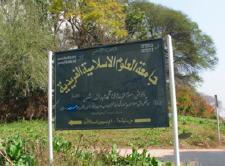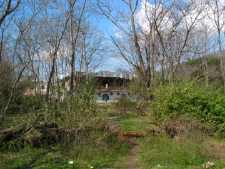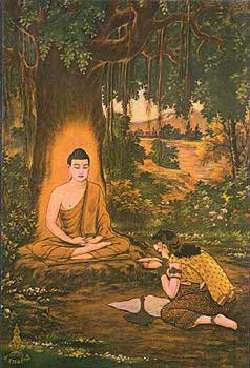In my last two posts on Islamabad (here and here) I talked about the woods and the forest trails that I love so much and take to them whenever I can.
In those woods, at the foot of the Margallas, until a few years ago, there was a very large and very old tree, believed to be several hundred years old. Its gnarled branches sprawled like an umbrella over a very large area around the tree.
It was a pipal tree (ficus religiosa). Pakistani residents of Islamabad were generally unaware of the significance of this tree. But the tree attracted many expatriate residents, mostly from South East or East Asian diplomatic missions in Islamabad. They would come and simply contemplate the tree and its surroundings. Someone had even a built a concrete kiosk and a concrete bench next to the tree for visitors to sit. The tree was believed to be a Bodhi tree.
What is a bodhi tree and how it came to be in Islamabad?
As many of us would remember from our history books, that is, if one graduated before the 1970s, for afterwards they stopped teaching history of pre-Muslim era of the subcontinent in schools, prince Siddhartha Gautuma meditated under an old pipal tree in Gaya, a village near Patna, Bihar, some 2,500 years ago. Ultimately he achieved nirvana, or was “awakenedâ€.
Consequently, the tree under which he sat was named Bodhi, meaning “awakening.†Sidhartha Gautuma became Buddha (the awakened) and the village came to be known as Bodh Gaya, the name it still carries today. The Bhodi tree that grows in Bodh Gaya today is believed to be a direct offspring of the original Bhodi tree.
In the centuries after Buddha, the Bodhi tree became a symbol of Buddha’s presence and an object of devotion for Buddhists.
A little more history before I get to the pipal tree in the woods of Islamabad.
King Ashoka (died 232 BC), the third Maurian king, converted to Buddhism and became a great advocate of the religion and actively propagated Buddhism throughout his empire. The Mauran Empire included, other than the present Northern India, the Gandhara region, which included the area around present day Islamabad, the Peshawar valley and parts of Afghanistan and Iran. Taxila (then Taxshashila), Peshawar (then Parshpura) and Charsaddah (then Pushklavati) were important cities of Gandhara. It was at this time that Taxila reached the peak of its development and became the center of Buddhism. Chandra Gupta Mauria and Asoka spent time at Taxila and so did their famous political adviser, Chanakya, who taught at Taxila.
King Asoka’s daughter, Sanghamitra, who became a Buddhist nun, is said to have taken a cutting of the Bohdi tree from Bhod Gaya to Sri Lanka and planted it at Anaradapura, the ancient capital of the island, where it still grows. Many temples throughout the Buddhist world have bodhi trees growing in them, which are or are believed to be offspring of the one from Anaradapura.
Now, back to Islamabad.
The old pipal tree that grew in the woods of Islamabad was also believed to be “descendent” of the Bodhi tree in Gaya, possibly planted, centuries ago, by a devotee, alongside a temple that might have existed there. Taxila, as the crow flies, is only a few miles from Islamabad, and is full of Buddhist monuments – stupas, statues and remains of monasteries.
In the 1980s, Ziaul Haq ruled Pakistan. In his zeal to “Islamize†the country, he encouraged and helped build madrassas all over the country, many with Saudi money. One such madrassa was built in the woods of Islamabad, not far from where the Bodhi tree stood. Over the years, the madrassa expanded, as most madrassas do, violating the building codes and encroaching upon state land, to become one of the largest madrassas in Islamabad. Today, it occupies 5-7 acres of prime real estate in Islamabad and has a sprawling building complex, and a very large playing field – probably larger than any school or college in Islamabad might have.
The madrassa houses a couple of thousand students ranging in age from 6 to 26, or even older. One sees them during breaks in their classes when they swarm into the playground and overrun the nearby children’s park, driving the children and women out. It is a bizarre sight to see young bearded men swinging and sliding on the swings and slides meant for children. Other contributions of these madrassa students to the community are: street signs defaced with posters soliciting sacrificial animal skins, and vandalized letterboxes.




Fortunately, because of its very large girth, the Bodhi tree did not burn down completely even though it was badly damaged. It survived with half of its branches still intact. The city administration tried to preserve what was left of the tree. They even posted guards at the site for sometime after the incident to protect the tree from any further attacks. When I saw it last, a few years ago, it was still green and seemed as if it was struggling to recover from the wounds inflicted upon it.
Last week, having returned to Islamabad after two years, I decided to look up the tree, as if you would look up an old friend, and see how it was doing. I was shocked. There was no tree there! Only a few logs of the decapitated tree were lying around like dead bodies. The concrete kiosk next to it was partially demolished, its remaining walls covered with graffiti, and the bench was gone. Through the woods, I could also see the madrassa, some construction work going on it. Still expanding, I guess.




(All pictures, except the first, by the author)





















































Joel,
I am not aware of any active Buddhist temples or a Buddhist population in Pakistan.
Interestingly, in the first few centuries of the Common Era 90 percent of the population of what is today Pakistan was Buddhist. Taxila was a great Buddhist center. Mahayan Buddhism (one of the two branches of Buddhism) started in Taxila and, from here, was taken to Tibet, China, Japan and Vietnam. The Gandhara tradition of making Buddhist statues was also born in Taxila under the influence of Greeks.
Dear Pervaiz Munir Alvi: I hope I’m not speaking out of turn in typing my thoughts in response to your above query to Ahsan.
You question necessitates a nuanced answer. In spirit, most Hindus will readily acknowledge Sikh,Christian and Islam’s Prophet(s) as Divine representatives/embodiments. In that sense Hinduism – itself no monolithic or definable entity – has already taken in the other religions into its fold. Whether the Prophets are viewed as avatars or vibhutis or saints or seers or sages is often left to the individual with never any consensus. For ex, there are many small groups that claim their spiritual guru or a particular saint to be the 10th Avatar, traditionally called Kalki (meaning of-tomorrow). Nobody really cares to refute or prove one way or another.
In a practical sense, there are individuals I know, even from Orthodox Brahmin households, that have a picture of Jesus on their altar. I suspect Islam and Sikhism dont lend themselves to such easy absorption because of the lack of photos/idols. Of course, such individuals are few.
On a broader, vaster scale, I don’t think we should envisage an absorption happening in terms of current forms. I suspect Hindu religion itself will evolve away into the spiritual side (which is quite entenrenched in the form of yoga,self-seeking,self-realization,etc) with the religious side getting less prominent and less central. In the younger generation, already, there is a growing tendency to re-find one’s religion not in (traditional) religion but in the mystic/metaphysical side. I think this trend will intensify. In which case, its possible Islam/Christianity/Buddhism/Hinduism/XYZ will be cast away only to fuse together in a higher synthesis, more pertinent to the age we live in. We can actually see this happenning with respect to Christian societies where small sections already take spirituality – as opposed to religion – seriously, and often the forms/knowledge of these efforts are inspired from Eastern mystical/metaphysical sources. In that grander sense, the answer would be a yes. In the narrower sense of religions, I think not.
In year 2004 the tree was burnt … an hype was created and teh things went down the drain, like all other matters.
It was so saddening at the very thought that people can burn a tree in name of Islam – Just bcoz it’s famous with a relation to Buddha (who himself could be a prophet)!!!
MQ, it’s sucha wonderful post- well written and well researched — Thanks for such detailed intro :>
I also remember very well when the Bodhi tree was first attacked many years ago. What I find sad and surprising now is that at that time it became the talk of the town, the CDA stepped in, everyone was talking about it, people were (at least in words) shocked, and the press was writing about it. Something was even done about it, in the building of a resting structure near it, etc.
What you are telling us now is that sometime between then and now the tree was actually destroyed. This time no one found out, or no one cared. As we readied this post we struggled to fin something, anything, on the internet about this incident. We did not.
Ultimately, the silence may be as incriminating as the act.
Wow.. what sad news.
Being a Karachi boy, I’ve only had the opportunity to visit Islamabad a handful of times. On on visit, when I was there for a youth camp, a couple of my Islamabadi friends decided to take a bunch of us to the “haunted” buddha tree (I understand that there isn’t much too do in Islamabad late at night :).
As 17 year olds do, they filled us with stories about a old, “haunted” tree in the woods. We parked our car facing the woods, turned on the headlights (a very stupid thing to do indeed) and headed off into the woods to find this mysterious tree. Luckily, a couple of the less gung-ho members of our party gave way to their fear of the dark soon and we headed back, avoiding potential snake bites/wild boars/crazy madreesa idiots/robbery/battery failure/run ins with actual ghosts!
I’m telling this story because even though we were bored 17 year olds, this tree gave us something to do. It seemed to be almost legendary in Islamabadi circles and many stories revolved around it. Now that it is gone, its sad to know that a future generation of kids there will grow up with one tale less to tell and one less crazy thing to do. Its things like these that contribute to the culture of a city and give concrete and pavement life.
Perhaps the only real ghosts haunting it now are those of tolerance and liberty, which seem to have both died tragic and untimely deaths in my country.